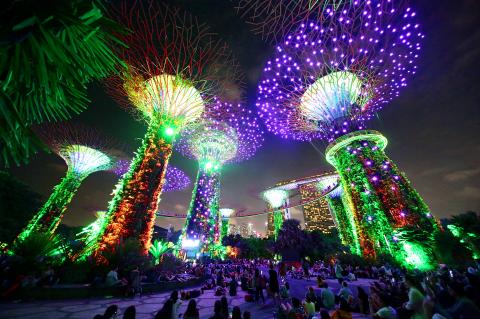They are places that encapsulate Singapore: Gardens by the Bay, with its gigantic artificial trees and botanical conservatories dripping with orchids; Lau Pa Sat, the colonial-era food hall beckoning with chili crab and chicken rice; Jewel Changi Airport, the futuristic shopping and entertainment complex straight out of Crazy Rich Asians.
All of those landmarks, and many more, are the handiwork of a company that has endured for nearly a century under a single family: the Yongs. Since the 1920s, when tigers still roamed what was then a steamy outpost of imperial Britain, the Yongs have been shaping the cityscape.
Today, a fourth generation is preparing to take over leadership of the family’s private empire, Woh Hup Holdings Pte (和合控股).

Photo: EPA-EFE
That the Yongs have maintained control of Woh Hup is testament to Singapore’s transformation as well as the clan’s shifting focus from basic infrastructure — such as prisons and piers — to entertainment and luxury apartments.
Woh Hup executive director Eugene Yong (楊康榮) is the first to admit construction is not a glamorous job.
“It’s more important that people are proud of what we’ve done,” the 67-year-old said.
Still, however low key the family might be, serving as a contractor to some of the nation’s biggest property projects has created fabulous wealth.
Woh Hup’s revenue in the year through June 30, 2018, was S$1.1 billion (US$787 million at the current exchange rate), up 31 percent from the year prior and net income totaled S$51.8 million.
The family declined to disclose any more recent data, but according to Bloomberg estimates, the clan is worth about US$600 million.
Woh Hup traces it origins to 1927, when Yong’s grandfather, Yong Yit Lin (楊溢璘), founded the group after moving from Malaysia in the pursuit of government construction tenders.
Yit Lin, originally from China, got his first big break as a contractor when he scored a job building fences and garden-gate posts for a British residence.
In Singapore, the business expanded to deliver large-scale projects, such as Clifford Pier, Changi Prison and the former Ministry of Labor, buildings that helped fill in the city’s landscape in the early years.
Yong’s father, Yong Nam Seng (楊南星), took over the business as a second-generation member in the late 1950s and is still Woh Hup’s chairman.
Eugene’s older brother, Yong Tiam Yoon (楊添榮), is deputy chair.
Now that Woh Hup is into its fourth generation, it is easily defying the stereotype that the third generation of wealth tends to blow through a fortune.
Michelle Yong (楊潔儀), Nam Seng’s granddaughter, is one of the new guard. She joined the family business in 2007 after studying and working in the UK and heads Aurum, a wholly owned subsidiary that focuses on boutique residential properties.
Key to Woh Hup’s success has been its ability to diversify.
“So many family members had already added much value,” the 41-year-old said in an interview from an office in Tanjong Pagar, a district where Chinese trading and tea houses have made room for yoga studios and fashionable bistros.
“When the Aurum opportunity came up, it was a chance for me to take the reins and try to make something out of it,” he said.
Other businesses Yong has helped spearhead under the Aurum umbrella include coworking firm Found8, venture capital outfit Aurum Investments Pte, which nurtures property technology start-ups, and Core Collective, a collaborative center for fitness and wellness professionals.
Aurum reduces reliance on Woh Hup, which Yong referred to as the “castle.”
She described her other ventures as “little villages outside the castle” that contribute to its success.
Found8 has plans to expand beyond Singapore and Malaysia, for example, while Yong is also considering a retirement living concept.
“I do believe that if you have too many people fighting over the same steering wheel, it can lead to problems,” she said. “It’s better to create a lot of opportunities for not just family members, but also team members to grow.”
As a mom to three children with another on the way, Yong knows something about multitasking. Having domestic live-in help also plays a part, as does Yong’s husband.
“He’s the one who gets the two older boys ready for bed every night so that I can work late if need be, and he also takes them out for boys-only trips to give me some down time at the weekends,” she said.
Still, Yong does not like the word sacrifice; as a mom, she has incorporated flexibility into the companies she runs.
“Being an entrepreneur and being my own boss definitely gives me a lot more flexibility than if I were just an employee,” she said. “I’ve brought the baby into the office, and we’ve turned meeting rooms into a creche. At Found8, there’s a nursing room and working moms can bring their children in so long as they don’t disrupt other members. We have a very baby-friendly policy.”
On the question of whether her kids would be Woh Hup’s fifth generation, Yong said she would like them to, but there are not any obligations.
“In fact, we’re starting to think about family governance, like corporate governance, where we set rules as to what expectations we have of different family members wanting to join the business,” she said. “It’s got to be merit-based rather than a charitable handout.”

CHIP RACE: Three years of overbroad export controls drove foreign competitors to pursue their own AI chips, and ‘cost US taxpayers billions of dollars,’ Nvidia said China has figured out the US strategy for allowing it to buy Nvidia Corp’s H200s and is rejecting the artificial intelligence (AI) chip in favor of domestically developed semiconductors, White House AI adviser David Sacks said, citing news reports. US President Donald Trump on Monday said that he would allow shipments of Nvidia’s H200 chips to China, part of an administration effort backed by Sacks to challenge Chinese tech champions such as Huawei Technologies Co (華為) by bringing US competition to their home market. On Friday, Sacks signaled that he was uncertain about whether that approach would work. “They’re rejecting our chips,” Sacks

Taiwan’s long-term economic competitiveness will hinge not only on national champions like Taiwan Semiconductor Manufacturing Co. (TSMC, 台積電) but also on the widespread adoption of artificial intelligence (AI) and other emerging technologies, a US-based scholar has said. At a lecture in Taipei on Tuesday, Jeffrey Ding, assistant professor of political science at the George Washington University and author of "Technology and the Rise of Great Powers," argued that historical experience shows that general-purpose technologies (GPTs) — such as electricity, computers and now AI — shape long-term economic advantages through their diffusion across the broader economy. "What really matters is not who pioneers

TAIWAN VALUE CHAIN: Foxtron is to fully own Luxgen following the transaction and it plans to launch a new electric model, the Foxtron Bria, in Taiwan next year Yulon Motor Co (裕隆汽車) yesterday said that its board of directors approved the disposal of its electric vehicle (EV) unit, Luxgen Motor Co (納智捷汽車), to Foxtron Vehicle Technologies Co (鴻華先進) for NT$787.6 million (US$24.98 million). Foxtron, a half-half joint venture between Yulon affiliate Hua-Chuang Automobile Information Technical Center Co (華創車電) and Hon Hai Precision Industry Co (鴻海精密), expects to wrap up the deal in the first quarter of next year. Foxtron would fully own Luxgen following the transaction, including five car distributing companies, outlets and all employees. The deal is subject to the approval of the Fair Trade Commission, Foxtron said. “Foxtron will be

BUBBLE? Only a handful of companies are seeing rapid revenue growth and higher valuations, and it is not enough to call the AI trend a transformation, an analyst said Artificial intelligence (AI) is entering a more challenging phase next year as companies move beyond experimentation and begin demanding clear financial returns from a technology that has delivered big gains to only a small group of early adopters, PricewaterhouseCoopers (PwC) Taiwan said yesterday. Most organizations have been able to justify AI investments through cost recovery or modest efficiency gains, but few have achieved meaningful revenue growth or long-term competitive advantage, the consultancy said in its 2026 AI Business Predictions report. This growing performance gap is forcing executives to reconsider how AI is deployed across their organizations, it said. “Many companies